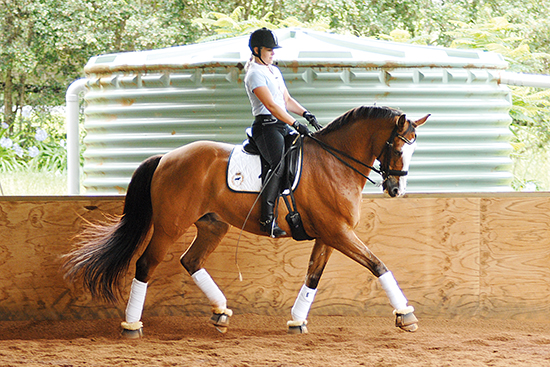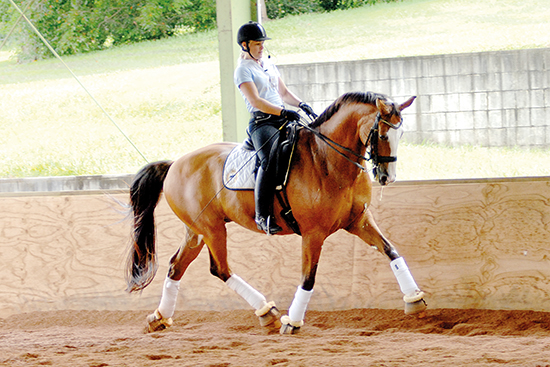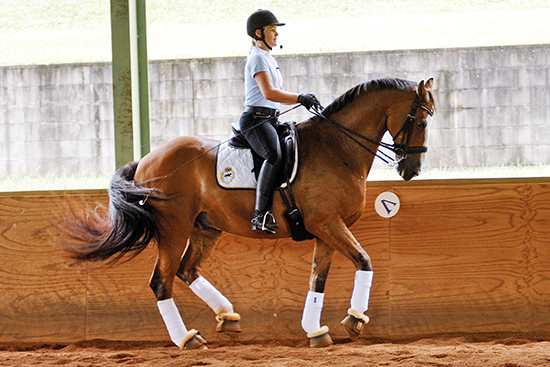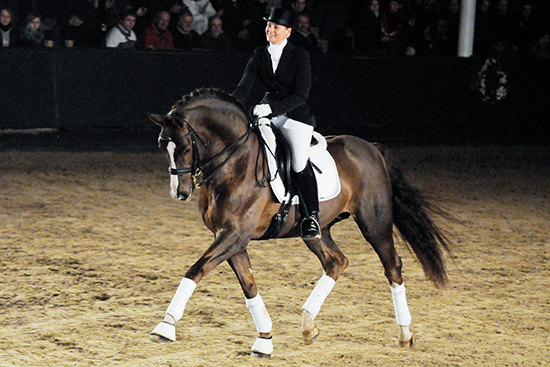 Story by Shannan Makauskas and Photos by Alex Makauskas
Story by Shannan Makauskas and Photos by Alex Makauskas
If you’ve been to any clinic in the last decade, you’ll know the recurring theme is changing the pace, within the pace, call it a half halt, forwards backwards, or simply an adjustment – it’s paramount to enhancing the horse’s natural movement. But if we all know this, why is it what visiting clinicians have to focus on again and again?
At the WEG I listened to Brett Parbery talk about his training with Edward Gal, how it came down to having complete control over the horse’s footfalls, creating gears and being able to access them whenever he wanted. Yes, he knew about half halts and adjusting the pace before, but by developing a system focussed on just that, you can take it to another level.
It’s time we refine this technique by breaking it down to its simplest form, and sometimes it takes a fresh perspective to flick the switch and have the light bulb come on, a task Hayley Beresford was managing with Jessica Greelish in their final lesson together.
Hayley said: “I like to explain it like using a clutch in a manual car. The feeling of the clutch, changing gears, is the same as changing the pace. Everything must change smoothly. It helps to think, up a pace, clutch in, up a bit more, not that it’s jerky.”
Before accessing these gears, Hayley goes through the motions: “Start with some rising trot, straight, nose in the center, shoulder in, leg yielding.” These movements are done with a sole purpose – to engage the horse’s core. A task managed by controlling what Hayley refers to as the ‘four corners of the horse.’ Which means having control of the shoulders and the hips of the horse, an image that is better grasped when you imagine sitting in the saddle like Hayley, or like ‘riding a big Harley Davidson,’ as she put it in part one of this series.
Hayley demonstrated from the ground by pretending to sit on a horse, her heels deep, her weight in her seat bones and her hands low and wide. She refers to her hands as her ‘training wheels’, which you see her mentor, Isabell Werth, pull out every time she circles the competition arena before starting a test:
“When you can control both shoulders and both hips, then you can start to move the belly around, the core of the horse, only then can you worry about the head carriage and the hocks. When you’ve got control over the core of the horse, you can ask for more activity. When you ask for activity, and the horse is blocked in their core (they’re not supple, not swinging) then you get resistance in the half halt, in the piaffe and in the passage.”
After working on suppleness, Hayley got down to generating more activity from the hind legs by helping Jessica gain control over the paces, within the pace: “Now you can do a bit more suppling and getting him gymnastic behind, take a bit more time, like you’re driving a car with a clutch, put your clutch in, slowly release the clutch and ask for the next gear, so that everything blends.”
To get Jessica to understand the range of gears within each pace, Hayley wanted to establish several gears: “Trot on the circle and trot bigger, shoulders on the circle, hips on the circle and swing. If this is third gear, show me second gear, put the clutch in and transition. Okay, now you better show me first gear because that was too much, you’ve got nowhere to go from there.”
First, work out how many gears you have. This is Hayley’s system: “Working trot is between three and five. From five we go up to six (lengthen) and seven (extended). Between one and three you’ve got collection, one being passage, and piaffe being something else, because when you get more technical, passage has gears of its own.”
“So, if working trot is between three and five, when I say more forward, you shift him a fraction forward and ride at that pace, then you shift him a fraction more forward and ride him at that pace, you have to have access and flexibility of the gears, you have to be able to do what you want, when you want, however you want. That’s the key, the flexibility, the suppleness.”
Jessica rides a very collected trot – third gear – it’s not passage but it’s the preparation before it. From here (third gear) Hayley instructs Jessica to move up to fourth gear, the collected trot you would ride lateral movements in. Define what your gears are and work on adjusting between them: “I like to use the gear system because it’s just a way of opening and closing the back, but you have to focus on the suppleness, the ease of moving between forward and back.”
Demonstrating the range of gears, Jessica rode on a 20 metre circle with Hayley barking out the orders: “Now I want you to think fourth gear, the contact has to stay the same, now I want you to think fifth gear, come, sixth gear, seventh gear, sixth gear…”
Parador has a huge range of motion within the collected and extended trots and it was fun watching for the transitions, barely detectable, but certainly there. When it came to the passage, gear one, things got a little sticky: “No, that was too much backwards, you closed the wither, replenish the gas and go back to third gear, let him be round on his own, you have to sit independent from him, don’t use your hands to sit back on his mouth.”
Hayley felt Jessica was relying too much on the hand to hold Parador in gears one and two – the passage. Instead of pulling him back a gear, she needed to shift down a gear: “Take your time, feel the corners of the horse, get him supple in the core, then bring him down a gear. See what I mean? If you give yourself more time, then you have a bit more flexibility through the rib cage, let him down in the neck, let him stretch in the passage. What I’d like to see when you ask for more cadence is that you can do it and stretch the horse at the same time so he’s not dependant on your hand. Of course you can keep a rhythm with your hands, but it must be in rhythm with the hind legs, it must be elastic.”
Hayley wanted the aid for the passage to come from Jessica’s leg: “Try to come into the steps without bringing the horse backwards, go forward in the trot now and from that forward to passage steps, good, just three or four steps, that he starts to play with the gymnastics of it.”
They went back to playing with the gears: “Three, two, forward, three, circle, two, one, now come! Good and out to two, three, don’t get stuck, four, three, two, tuk, tuk, one, come, come, energy! Not with your whip, the reaction must come from your legs. Transition to walk and pat. That needed to be more fluent, but very good job Jess.”
During the walk break, Hayley reflected on her experience: “When I’m riding I find it helps to keep a metronome, then you just bring the passage in there like a play toy, you can’t train rounds and rounds of passage. One of the most amazing things I’ve seen watching Isabell is the horses want to do it, they want to do the tricks because it’s play time and it’s always a game. It’s just five steps passage and then you make a big deal about what a good job they’ve done, so the next time you want to come passage they’re offering it more and more. You want them to think they are hot stuff when they’re doing it.”
Hayley pointed out where things were going wrong with Jessica and Parador in the piaffe, passage tour: “You have to get him independent of the whip. You have a very, very good horse, you have a very good Grand Prix horse, and he’s honest, he will do it as well as you ask him to do it, but only for as long as he wants to do it. We have to make him want to do it.”
On the next attempt, another hurdle presented itself: “You need gas, you can’t go with an empty tank into piaffe or passage. Go from your third gear, now into second, think of the silhouette (outline), soften the neck, now first gear (passage), come, come, now a bigger passage, we’re working in gears of passage now, not gears in trot okay? So go to third gear passage, make it really free, four, I want it bigger, three, two, soft hands, bend the neck, and okay now we can see that’s the problem huh? It’s too tight, he can’t do it.”
Jessica said: “When I close my leg in passage, he thinks I’m asking for piaffe.” Hayley responded: “I don’t think you give enough warning, you need to take more time bringing him in. Let the passage be more free, un-complicate it, you’re trying too hard. You have to be more in your seat, feel the rhythm, don’t clamp on. He has to answer the leg. You’re not being clear enough about what you want.”
Hayley finds the solution in going back to the basics: “Because we’ve started something new I think you’ve just thrown everything else out the window. Go on a circle again and remember it’s only piaffe, passage. Start in normal working trot. Think about everything we’ve just worked on. We need more gas, go to fourth gear in trot, now come three, two, one. Move forward with your hips, don’t use your hands to come back, kick and give, let him carry his own head, forward again, fourth gear, third gear, sit deep, second gear, and tuk from the back into first gear, good! Pat him, that was good.”
“The only mistake you made then is you didn’t get out early enough. It’s just he’s not sure how to handle the pressure yet, you’ve got to make him brave, he’s scared and he’s saying I don’t know what to do. You’ve got to make him like I’m so hot because I can make piaffe. Remember not to use too much hand, it’s got to be like your reins are cotton, just play, and out and tell him he’s fantastic.”
Hayley and Belissimo M
When it came to making the transitions in and out of piaffe, Parador was panicking. Hayley had a simple solution: “He’s getting really road blocked huh? It’s very important to stay cool. We need to think about the baby Grand Prix test like we have in Europe, which is half the time and the piaffe’s only five or six steps spread over two metres. Then slowly forward and trot. Just piece it together bit by bit, so he gets more confident. Go normal trot, then passage, then walk two or three steps, then piaffe, good and forward, well done, tell him he’s fantastic. All you’ve got to do is to give him confidence.”
Letting the horse walk for two or three steps between the piaffe and passage transitions took the pressure off, and when it came to the next attempt, Parador was confident enough to offer the piaffe: “Easy ha?” said Hayley, “You try too hard, that’s the only mistake you make, and we get a bit desperate because it’s all so new, I know the feeling. Don’t worry, the answer is to simplify. So what if you make some transitions at home with some walk steps, you did it once and then he offered you the transition. He’s so intelligent, but he’s so sensitive that you can’t confuse him.”
This was a great strategy for a horse like Parador, an honest horse with energy to burn who’s always offering activity and expression. Jessica was certainly pleased with the result: “I thought all the lessons were great, Hayley certainly has a massive bag of tricks and she explains things really well. She’s helped me with every facet of my training, but what I love is her concern for the horse’s mental well being, she’s very big on positive reinforcement, combined with her competition success, it’s a really balanced way of training.”
It was a privilege to watch Hayley work with the Queensland riders, not only is she down to earth but she takes an intelligent approach to dressage – one that is both classical and yet driven toward competition success. Now that she’s based back in Germany at the International Dressage Stables of Zucht and Sport Pferde Schmidt, she has gained the ride on the already legendary stallion, Belissimo M – a record breaking Stallion Performance test winner, Bundeschampion, and finalist at the World Championship for young dressage horses. Combined with the support of long time sponsor, Eduardo Fischer (owner of Relampago do Retiro), we will continue to see big things from Hayley in the future, and learn from her success.
This article first appeared in the April 2011 issue of THM.


